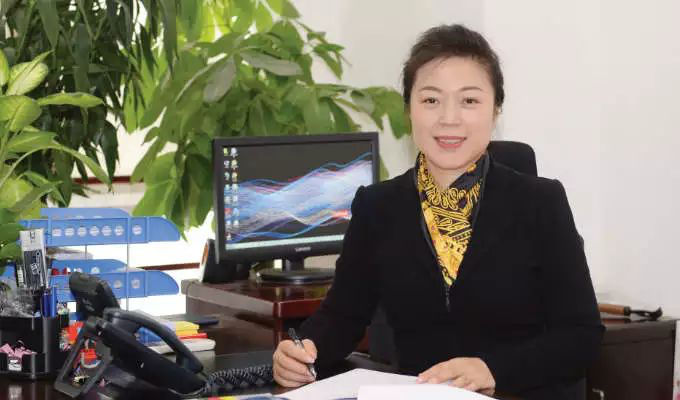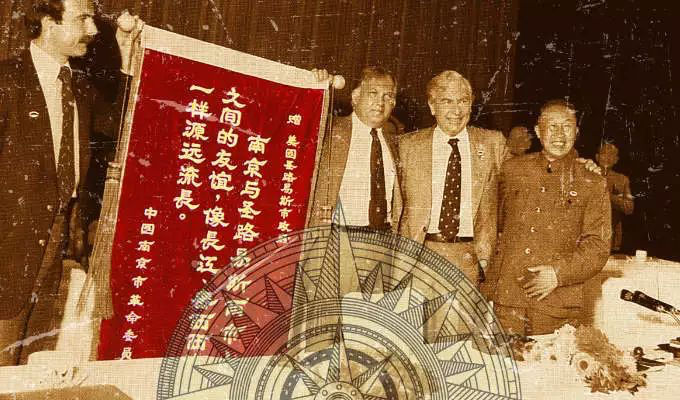In 1978, China began her period of Reform and Opening Up (găigé kāifàng; 改革开放). One of the ways China opened up to the world was through the official forming of city and province “sister partnerships”. Today, Nanjing boasts 20 formal Sister City relationships, of which St. Louis of Mississippi, USA, became the second in 1979. This year, Nanjing therefore celebrates 40 years of formal diplomatic relations with the USA and the city of St. Louis.
In January, 1978, St. Louis established a community of prospective friendship cities. At the beginning of 1979, then Mayor of St. Louis, James Conway, wrote a letter to the then Head of Nanjing, Chu Jiang, detailing similarities between the two cities, which included geography, industry, culture and economy (both cities are major inland ports that lie on the banks of a vast river and were, at the time, highly industrialised, while each is regarded as a gateway to their respective country’s western region). The letter was sent to the Chinese Ministry of Foreign Affairs, as the system in place at the time required central approval for all foreign contact. In June of the same year, a delegation from St. Louis flew to Nanjing for the first time. They returned in November, whereupon the document which solidified a formal Sister City relationship was signed in the Nanjing Great Hall of the People.
“Generally speaking, we have three categories that we use to establish contact with international cities”, said Li Aijun, head of the Nanjing Foreign Affairs Office, speaking with The Nanjinger in an exclusive interview.
“The first category is when an overseas city initially contacts us. The second is where we look for and choose cities from our side. And the third is related to history; at the beginning of the reform and opening up, the Foreign Affairs Ministry helped us to make the contacts.

“This year marks the 40th anniversary of the establishment of diplomatic relationships between China and the United States. So our story and friendship with the city of St Louis also goes with the communication and exchanges between the two countries and people”, said Li. In Xuanwu Lake park, the St. Louis delegation planted four trees around which were colourful ribbons. The tree chosen for the occasion was the Liriodendron that is now only found in China and the USA.
In 1980, Chief of The People’s Liberation Army, Deng Xiaoping, gave permission for a small (six people) delegation from Nanjing to visit St. Louis. Due to limited funds at the time, China only permitted small groups to travel abroad, a tradition that lasts to this day. The first group to visit St. Louis left Nanjing in May 1980 and included the Vice Head of Nanjing, Wang Chubin; it was the very first time the local Nanjing government had visited America. The group were picked up from the airport by St. Louis officials in San Francisco, who then accompanied them on the entire trip to various cities.
Official Nanjing memoirs that were given to The Nanjinger by local government document how the tour group was treated by the Americans. On the second day, they were treated to a feast, with 500 people from all walks of life. In the 9 days that they were in St. Louis, they visited more than 30 places, including six large corporations, nine factories, some universities, farms, hospitals, museums and shopping malls. They were left with a deep impression of the development of the city, the education, industrialisation and agriculture, calling it, “striking modernisation”.
An attendee said of the conference that took place in Nanjing upon their return, “This report is based on fact, the content is detailed and vivid, down to earth and about daily life. The people said this is the very first time to hear such a kind of report of a visit overseas, from a representative in the community after the opening up and reform of China. Although we had 3 hours to listen to the report, it just was not long enough. And even though we sat there for 3 hours, we didn’t even feel tired”.
Li told The Nanjinger, “When we get to work on relationships with all the friendly cities, including friendship and sister cities, we do not make any difference between them. Just in terms of the official documents and some official procedures, this makes the only difference”. Understanding why the Chinese refer to Sister Cities as Friendship Cities is important, as it differs from the international process in regard to Friendship and Sister City terminology. “From the beginning the term Sister City originated from the United States, but the Premier at the time, Zhou Enlai, who was the forefather of Chinese diplomacy, noted that in Chinese we call sister ‘jiemei’ (姐妹), which means bigger sister and younger sister; you have a difference in terms of the ages, so that will make it unequal. … So, Premier Zhou suggested that we call it ‘youhao chengshi’ (友好城市), which will be very equal.”
One of the purposes for China to make such relationships was to enhance the understanding and friendship between two cultures. In the late 70s, China did not have any convenient ways of accessing information. Local people only to knew about overseas activity through outdated newspapers, TVs and films. Thus the Nanjing-St. Louis exchanges made big news at that time.
Looking back, Li said, “At that time many Chinese people did not think of the States as a very friendly country, but when the Nanjing delegation got to the States they found it was totally different from what they had thought. They found the States was very developed. Furthermore, the Nanjing people found that we had a very large gap between Nanjing and the States. We needed to work hard to reform, to build our city. … Through contact with other cities we’ve learnt the concept of building a city. For example, environment protection, how to build a city, how to do urban planning of a city and so on, we have learned a lot from our friendly cities”.









